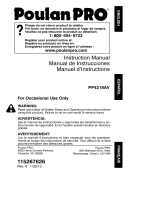
• Keepthehandlesdryandcleanand
freefromoilandgrease.
• Keepoilcapandfastenerssecurely
tightened.
• Nonconformingreplacementcompo-
nentsortheremovalofsafetydevices
maycausedamagetotheunitandpos-
sibleinjurytotheoperatororbystand-
ers.UseonlyPoulanaccessoriesand
replacementpartsasrecommended.
Nevermodifyyoursaw.
• Maintainchainsawwithcare.
• Keepunitsharpandcleanforbetter
andsaferperformance.
• Followinstructionsforlubricatingand
changingaccessories.
• Unplugthechainsawfromthepower
sourcewhennotinuse,beforeservic-
ing,andwhenchangingaccessories
andattachments,suchassawchain
andguard.
• Checkfordamagedparts.Beforefur-
theruseofthechainsaw,aguardor
otherpartthatisdamagedshouldbe
carefullycheckedtodeterminethatitwill
operateproperlyandperformitsin-
tendedfunction.Checkforalignmentof
movingparts,bindingofmovingparts,
breakageofparts,mountingandany
otherconditionsthatmayaffectitsop-
eration.A guardorotherpartthatis
damagedshouldbeproperlyrepaired
orreplacedbyanauthorizedservice
dealerunlessotherwiseindicatedelse-
whereintheinstructionmanual.
• Whennotinuse,chainsawsshould
bestoredinadry,highorlocked-up
placeoutofthereachofchildren.
• Whenstoringsaw,unplugandusea
barsheathorcarryingcase.
ELECTRICAL SAFETY
_ WARNING: Avoid a dangerous en-
vironment. To reduce the risk of electrical
shock, do not use in rain, in damp or wet
locations, or around swimming pools, hot
tubs, etc. Do not expose tosnow, rain, or
water to avoid the possibilityof electrical
shock. Do not handle extension cord or
plug with wet hands.
• Use a voltage supply as shown on the
nameplate of the unit.
• Avoid dangerous situations. Do not use
in the presence of flammable liquidsor
gases to avoid creating a fire or explo-
sion and/or causing damage to unit.
• To reduce the risk of electrical shock,
this appliance hasa polarized plug(one
bladeiswiderthan the other)and willre-
quire the use of a polarized extension
cord.The appliance plugwillfitintoa po-
larized extension cord only one way. If
the plug does not fit fully into the exten-
sion cord, reverse the plug. If the plug
still does not fit, obtain a correct polar-
ized extension cord. A polarized exten-
sion cord will require the use of a polar-
ized wall outlet. This plug will fit into the
polarized wall outlet only one way. If
plug does not fit fully into the wall outlet,
reverse the plug. If the plug still does not
fit, contact aqualified electrician to install
the proper wall outlet. Donot change the
equipment plug, extension cord recep-
tacle, or extension cord plug in any way.
• To reduce risk of electrical shock, use
extension cords specifically marked as
suitable for outdoor appliances. The
electrical rating of the cord must not be
less than the rating of the unit. The cord
must be marked with suffix "W-A" (in
Canada, "W"). Use a polarized cord.
Make sure your extension cord is in
good condition. Inspect extension cord
before use and replace if damaged. Do
not use a damaged cord. Cord insula-
tion must be intact with no cracks or de-
terioration. Plug connectors must be
undamaged. An undersized extension
cord will cause a drop in line voltage re-
sulting in loss of power and overheating.
If in doubt, use the next heavier gauge.
The lower the gauge number, the heavi-
er the cord (see SELECTAN EXTENSION
CORD in the OPERATIONsection). Do
not use multiple cords.
• Do not abuse cord. Never carry the
unit by the extension cord or yank ex-
tension cord to disconnect unit.
• Secure extension cord to power cord
to prevent disconnection from unit.
• Do not use the unit if the switch does
not turn the unit on and off properly, or
if the lock-out does not work. Repairs
to the switch must be made by an
authorized service dealer.
• Keep extension cord clear of operator
and obstacles at all times. Position
cord so that it will not be caught on
branches. Do not expose cords to
heat, oil, water, or sharp edges.
• To avoid the possibility of electric shock,
avoid body contact with any grounded
conductor, such as metal fences or
pipes.
• Ground Fault Circuit Interrupter
(GFCI) protection should be provided
on circuit or outlet to be used. Recep-
tacles are available having built-in
GFCI protection and may be used for
this measure of safety. Inspect chain
saw cords periodically and if dam-
aged, have repaired by an authorized
service dealer.


















